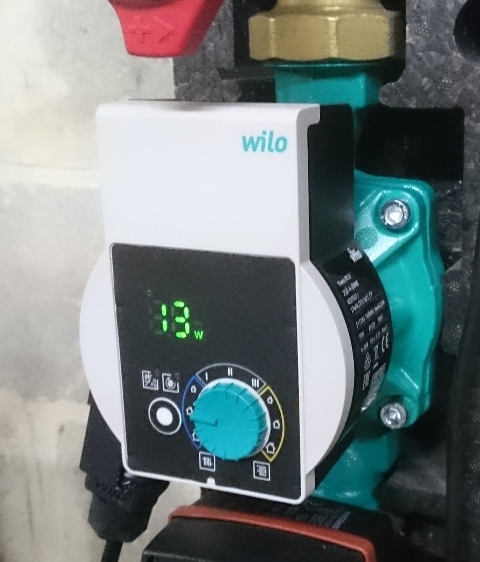Summary:
– How does heating circulators work?
– Purpose of the central heating circulator
– Advantages of the central heating circulator
– Disadvantages of the central heating circulator
– 3 main types of heating circulators
– Prices for heating circulators
The heating circulator (or circulating pump) is a key component for the proper functioning of the water central heating system. It ensures a regular supply of heat transfer fluid (usually water) to all the heat emitters in the house, regardless of their distance from the boiler. Since the central heating system is a closed circuit, the circulator only has to compensate for the pressure losses in the circuit.
How does heating circulator work?
The boiler circulator takes the form of an electric motor equipped with an impeller. Its role in the oil (or gas) heating system is to facilitate the circulation of the heat transfer liquid (often water) in the pipework and to increase the heating pressure. Hence, in cold winter you can get hot water instantly.
Purpose of the central heating circulator
In older installations, the heat transfer fluid, which was lightened after passing through the boiler, rose naturally towards the radiators located at the top. After transferring its heat to the ambient air, the denser liquid would naturally flow back down to the boiler for recycling.
The heating circulator makes it possible to overcome the physical inertia of the thermosiphon by pressurizing the fluid. Operation by thermosiphon requires large-diameter piping, with a constant upward slope for the outward journey and a downward slope for the return journey.
Note: the circulator minimizes the effect of pressure drops, which allows a drastic reduction in the pipe sections and simplifies the pipe routing.
Advantages of the central heating circulator

The advantages are numerous:
– A great reactivity (faster and better temperature adjustment) to the settings of your heat control system. Four products usually constitute a full heating control system (based on a home with a conventional central heating system): 1. a room thermostat, 2. a boiler programmer, 3. a hot water cylinder thermostat, and 4. thermostatic radiator valves.
– Easier installation of the boiler rooms (the boiler is no longer necessary in the lower part of the building, many counter slopes are allowed).
– Accessibility to new materials and heating systems (underfloor heating, octopus circuits, etc.).
– Better control of the path and lengths of pipes (passage in the basement or attic, embedding, etc.).
– A reduction in supply and installation costs.
Disadvantages of the central heating circulator
But there are also some drawbacks:
– An initial overinvestment.
– Dependence on a power supply.
– Significant energy consumption. Here is an indication of annual consumption (6,000 hours of heating) for a circulator of average power:
± 260 kWh / year for a class C or D;
± 170 kWh / year for a class B;
± 90 kWh/year for a class A (the most efficient and also the most expensive).
Good to know: It is electromechanical equipment susceptible to breakdowns (although not very common).
Note: The highly positive response in favour of the heating circulator and the widespread use of fine and programmable controls is leading to the phasing out of thermosiphon systems!
3 main types of heating circulators
All domestic heating circulators are equipped with an in-line vane pump. They are inserted between two sections of pipe. Some are surrounded by an insulating shell.
Using fine motor technology, they are cooled by water from the heating circuit and require no maintenance.
1. Standard circulators
They are the most widespread and the least expensive. They have 1, 2, 3, or 4 fixed speeds, selected manually.
Caution: they are equipped with an asynchronous motor with a reputation for poor efficiency, they are energy-hungry.
2. Variable speed circulators

In these circulators, the speed of rotation is continuously regulated by an electronic pulse cascade device or by a power converter.
If one or more valves close in the circuit (e.g. thermostatic valves), the pump flow rate is automatically lowered to maintain only the flow rate required at the operating stations.
Good to know: some of these circulators can be fitted with programmable mode and control of pump and circuit parameters (flow rate, speed, pressure, power consumption, water temperature, etc.).
3. Circulators with a permanent magnet motor

These electronic wet-motor circulators have a degree of regulation comparable to that of their predecessors, but allow energy savings of around 20%.
Note: Although still expensive, these devices offer the best ratio between energy savings and comfort optimization. They are becoming the new standard equipment for heating, air conditioning and domestic hot water.
Prices of heating circulators
Prices vary according to the type of circulator, the degree of sophistication of the system, the installed power, the brand and the distributor.
Here are the price indications for a class A circulator, medium power, excluding installation:
– standard circulator: between $90 and $130 inc. tax;
– electronic variable speed circulator: between $120 and $250 tax included;
– electronic circulator with permanent magnet motor: between $250 and $450 tax included.
For a standard circulator of class B, C or D, prices range from $60 to $90 including tax.
Where can you find heating and cooling specialists in Ontario?
If you are looking for specialists in the installing and servicing of heating and cooling units, look no further than Northumberland Gas & HVAC Mechanical in Ontario. They are a family run business with over 20 years of HVAC industry experience. They are accredited by the TSSA, fully insured, and covered by WSIB.

